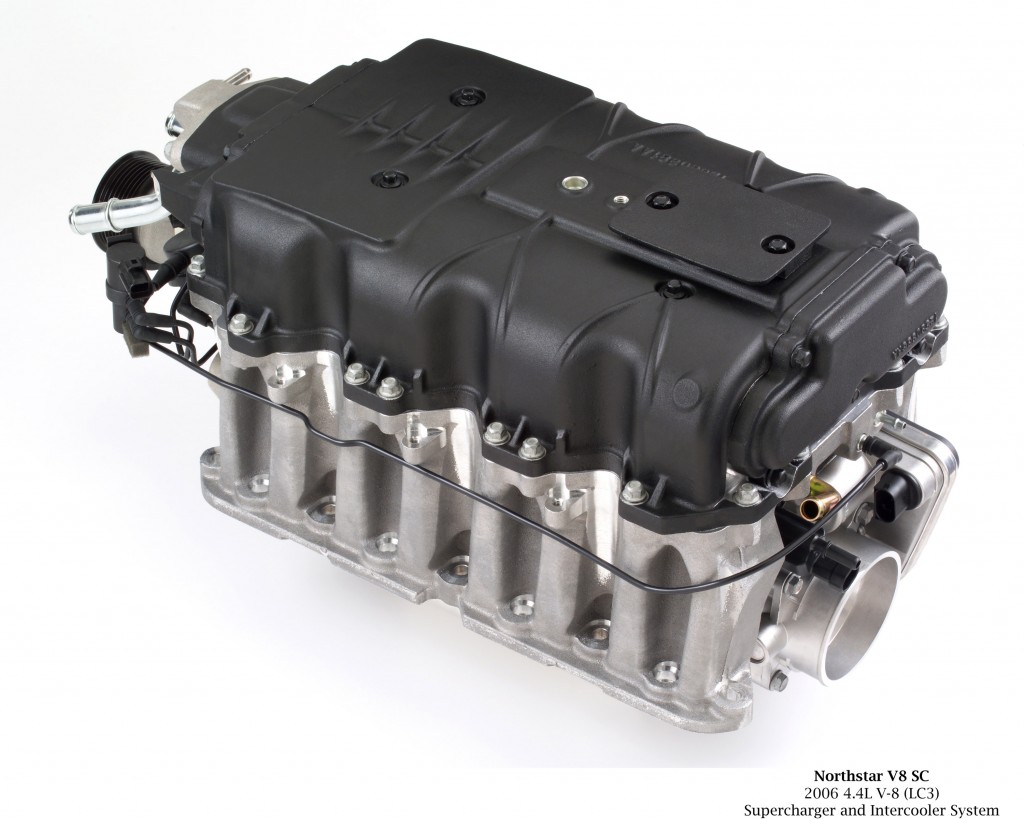The Cadillac STS-V (2006-2009) featured the 4.4L DOHC VVT LC3 V8 with a custom Eaton M122 Supercharger and integrated intercooler.
This photo shows the Cadillac LC3 engine without the ‘beauty cover’, looking from the rear of the engine — so the front of the Cadillac would be right and away.

Air flows in the black tubes at the top of the engine to the ‘back’ of the engine, and into the supercharger. Note the noise baffles in the intake tubing intended to isolate the whine of the supercharger.
This view is of the supercharger+intercooler from the back:

and the next view is the reverse angle or ‘front facing’ shot of the coolant in/out tubes flowing to the intercooler (black part). The ‘snout’ is the drive for the supercharger. A belt runs from a pulley below to turn the Supercharger, pressurizing the incoming air.

Once you open and separate the supercharger and intercooler they look like this — note the intercooler is flipped upside down here, as if you simply removed it by ‘opening it up’:

STS-V Intercooler removed from Supercharger
The intercooler is an air to water system, and features Laminova laminar flow heat exchange tubes.
The air flows into the back of the supercharger through the long intake. Then it is pumped up from the center of the supercharger through the intercooler past the Laminova tubes, and then it flows down the sides of the intercooler casing and the supercharger casing and into the engine.
Each of the four Laminova tubes look like this up close:

Laminova STS-V Intercooler Tubes
The science of the Laminova design is to create huge surface area with minimal air flow restriction. The very thin fins, 0.2 mm each, along each Laminova tube collect the heat from the air passing through the 0.3 mm gaps between the fins. The surface area presented to the air flow is approximately 5 times greater than a conventional plate-style intercooler according to Laminova, as well as reducing noise and pulsation.
The heat is conducted to channels surrounding the solid core of each Laminova tube, where liquid coolant is passing through to remove it.
It appears that the coolant flows into the intercooler, circulates through all 4 Laminova intercooler tubes, and then flows back to the intercooler heat exchanger. The heat exchanger is like a small radiator. The intercooler coolant system is completely separate from the engine cooling system/radiator.
The advantage of the Laminova design is that they have a very good efficiency with low pressure disruption and light weight. A disadvantage is cost.
The CTS-V LSA engine uses a finned box air to water intercooler:

This shot shows the CTS-V LSA intercooler upside down.
How can the STS-V intercooler be improved?
An interesting ‘science project’ for the STS-V intercooler would be to replace the intercooler endcaps that direct coolant flow through one Laminova core after another with a custom endcap that directed coolant flow in parallel with all 4 Laminova cores and out after one pass.
One expert mentions that it is helpful to ‘index’ the 4 Laminova cores, so that the large fins are facing the air flow. I am not clear looking at the images what is intended, as the Laminova cores appear to be uniform and symmetrical, unless the intent is to rotate the ‘sleeves’ the cores are contained in?
Owners are also experimenting with larger heat exchangers at the other end of the system, larger fluid reservoirs to allow more fluid to circulate and absorb heat, and higher capacity intercooler coolant pumps to circulate fluid.
On the slots that allow flow across the Laminova tubes, are the cross-pieces structurally needed? If removed, so that the slots were just continuous single slots — flow would be increased.
Do you see other avenues to explore?







